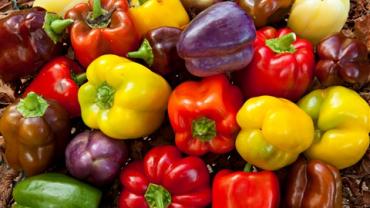
The array of fresh vegetables and fruits at farmers’ markets is a welcome sight in summer. From boldly colored blueberries and raspberries to yellow peaches and dark green spinach locally grown produce is as nice for the eyes as it is healthful for the body. While some foods are available year-round in warmer parts of North America other regions have limited growing seasons during which particular foods are especially delicious. An example of these limited-time foods in some areas are sweet bell peppers. Available in green red yellow orange and even purple varieties these versatile vegetables are as nutritious as they are eye-catching amidst summer’s beautiful bounty.
Bell peppers are available at supermarkets all year long but out of season they may be mushy mealy and just plain not taste as good as when they’re at their peak. This may not matter much when they’re destined to be cooked but when eaten raw—cut in julienne strips they make an excellent snack—they may lose some of their appealing crunch.
Like many other vegetables that are low in carbohydrate and high in fiber peppers fit nicely into many diverse nutritional strategies: low carb Paleo vegan vegetarian and just “real food.” No matter who’s coming to dinner and what their dietary preferences are bell peppers probably fit the bill. They provide great flavor with very few calories and a negligible amount of fat. However within that small number of calories peppers pack an impressive concentration of nutrients. Here’s how the “stoplight” peppers (red yellow and green) stack up in terms of the daily value (DV) for selected nutrients:
|
Pepper |
Vitamin A |
Vitamin C |
Vitamin K |
Vitamin B6 |
Folate |
Potassium |
Manganese |
|
103% |
349% |
10% |
24% |
19% |
10% |
9% |
|
|
7% |
569% |
~ |
16% |
12% |
11% |
11% |
|
|
12% |
220% |
15% |
18% |
4% |
8% |
10% |
("~" indicates a missing or incomplete value)
Red peppers certainly prove that carrots aren’t the only vegetables that provide vitamin A precursors (beta-carotene). Red peppers also contain quercetin and lycopene the latter being responsible for their red pigment (as well as that of tomatoes watermelon and other red/pink produce). Each of these peppers has an impressive amount of vitamin B6 and their vitamin C content is off the charts. Citrus fruit is another great source of course but peppers are a good alternative for individuals who have to limit their sugar consumption—even the sugars that occur naturally in fruit. Another good source of vitamin C—perhaps a surprising one—is broccoli. But since vitamin C is sensitive to heat—and raw broccoli is a challenge to chew!—it may be beneficial to get some from peppers especially if they’re eaten raw such as in a salad or on a crudité platter with dip or hummus. A quick sauté such as when they’re prepared for fajitas would also preserve most of the vitamin.
As is true for other brightly colored vegetables and fruits bell peppers are rich in wonderful antioxidants. Organically grown peppers may have higher levels of carotenoids vitamin C and antioxidants than those that are conventionally grown but this may also be affected by soil conditions and the specific cultivars. In general red and yellow peppers have higher antioxidant capacity than green ones but green ones are still good sources.
Like tomatoes and eggplant bell peppers are New World foods native to South and Central America but they long ago earned a beloved place in Old World Mediterranean and European cuisine. What would Spanish and Italian cooking be without them? (The same can be said for other types of peppers and the spices that are made from them. What would authentic chorizo and Hungarian goulash be without paprika and other sweet & hot spices?) However like tomatoes and eggplant bell peppers—as well as hot peppers—belong to the nightshade family of plants botanically classified as Solanaceae. (Other nightshades include white potatoes and tobacco.) Nutritional protocols for autoimmune conditions typically call for removing nightshades from the diet for some period of time then reintroducing to see if they are exacerbating symptoms. Individuals with arthritis may be sensitive to the compounds in nightshades.
For those without sensitivity to nightshades however bell peppers are incredibly versatile in the kitchen. They can be used raw in a refreshing summer salad (even better grilled!) used in a hearty winter chili and can be stuffed with meat or a vegetarian filling then baked until soft. And of course there’s nothing like the aroma that fills the kitchen when someone’s making sausages and peppers.
Sources